Analysis of Ultrasonic Vibration-Assisted Ball Burnishing Process on the Tribological Behavior of AISI 316L Cylindrical Specimens
Abstract
1. Introduction
2. Materials and Methods
2.1. Specimens’ Preparation
2.2. Ball Burnishing Equipment and Specimens
2.3. Experimental Campaign and Specification
- Burnishing force Fb: three numerical levels, from 80 N to 160 N with a central point in 120 N. Attabi et al. [21] found a surface degradation at slim plates with 240 N and a 10 mm ball, so by applying the radius corrections (in the function of ball mechanical and geometrical properties of the specimen) it is decided to apply a maximum force of 160 N to avoid surface degradation.
- Number of passes np: three numerical levels, from 1 to 5 passes with a central point in 3 passes.
- Frequency of the VA f: two different levels, being 0 or 40 kHz. Treated as a categorical variable.
- Burnishing speed: one level, being 2000 mm/min for all the specimens.
- Burnishing feed: one level, being 0.15 mm/rev for all the specimens.
- Indenter characteristics: WC-Co 6 mm ball of diameter, with 600 GPa and 0.22 values for Young’s modulus and Poisson’s ratio, respectively.
- Specimen characteristics: AISI 316L SS 13 mm cylinder of diameter, with 200 GPa and 0.25 values for Young’s modulus and Poisson’s ratio, respectively.
- Physical inputs: Force applied of 20 N, making an imprint length of 20 mm, sliding at 10 cm/s during 5 min of testing.
2.4. Topology Acquisition
- Sa: Represents the arithmetical deviation of the roughness profile of the sampling length.
- Sq: Represents the root mean square of the heights.
2.5. Microstructure Analysis
2.6. Residual Stress
3. Results
3.1. Topography
3.2. Microstructure Analysis
3.3. Residual Stress
3.4. Frictional Performance
3.5. Wear Resistance Analysis
4. Discussion
5. Conclusions
- Ball burnishing improves the average roughness of 316L shaft surfaces, and the vibration assistance improves this property, statistically, by 9% in average terms. The best parameters found in this study correspond to 160 N of force, five passes, and the activation of the vibration assistance.
- The coefficient of friction seems to be similar for all specimens tested. However, it is noticed that the vibration assistance could reduce up to 2.2% despite not being statistically significant.
- The increase in the residual stresses in the tangential direction is directly dependent on the number of passes and the force applied, while the axial seems to be similar for all specimens. The VA enhances the von Mises stress value by 11.5% compared to conventional ball burnishing.
- The wear decreased by 7.3% when using VABB instead of BB. It is also reported that the increase in the number of passes and the burnishing force helps to enhance its resistance. It is also found that there exists a relation between the von Mises residual stress and the wear of the tribology testing.
Author Contributions
Funding
Institutional Review Board Statement
Informed Consent Statement
Data Availability Statement
Acknowledgments
Conflicts of Interest
References
- Lodhi, M.J.K.; Deen, K.M.; Greenlee-Wacker, M.C.; Haider, W. Additively manufactured 316L stainless steel with improved corrosion resistance and biological response for biomedical applications. Addit. Manuf. 2019, 27, 8–19. [Google Scholar] [CrossRef]
- Teo, A.Q.A.; Yan, L.; Chaudhari, A.; O’Neill, G.K. Post-processing and surface characterization of additively manufactured stainless steel 316l lattice: Implications for biomedical use. Materials 2021, 14, 1376. [Google Scholar] [CrossRef] [PubMed]
- Bartolomeu, F.; Buciumeanu, M.; Pinto, E.; Alves, N.; Carvalho, O.; Silva, F.S.; Miranda, G. 316L stainless steel mechanical and tribological behavior—A comparison between selective laser melting, hot pressing and conventional casting. Addit. Manuf. 2017, 16, 81–89. [Google Scholar] [CrossRef]
- Vafa, E.; Bazargan-Lari, R.; Bahrololoom, M.E. Electrophoretic deposition of polyvinyl alcohol/natural chitosan/bioactive glass composite coatings on 316L stainless steel for biomedical application. Prog. Org. Coat. 2021, 151, 106059. [Google Scholar] [CrossRef]
- Bekmurzayeva, A.; Duncanson, W.J.; Azevedo, H.S.; Kanayeva, D. Surface modification of stainless steel for biomedical applications: Revisiting a century-old material. Mater. Sci. Eng. C 2018, 93, 1073–1089. [Google Scholar] [CrossRef]
- Tugay, I.O.; Hosseinzadeh, A.; Yapici, G.G. Hardness and wear resistance of roller burnished 316L stainless steel. Mater. Today Proc. 2021, 47, 2405–2409. [Google Scholar] [CrossRef]
- Bikdeloo, R.; Farrahi, G.H.; Mehmanparast, A.; Mahdavi, S.M. Multiple laser shock peening effects on residual stress distribution and fatigue crack growth behaviour of 316L stainless steel. Theor. Appl. Fract. Mech. 2020, 105, 102429. [Google Scholar] [CrossRef]
- Slavov, S.; Dimitrov, D.; Konsulova-Bakalova, M.; Vasileva, D. Impact of ball burnished regular reliefs on fatigue life of AISI 304 and 316L austenitic stainless steels. Materials 2021, 14, 2529. [Google Scholar] [CrossRef]
- Yilmaz, H.; Sadeler, R. Impact wear behavior of ball burnished 316L stainless steel. Surf. Coat. Technol. 2019, 363, 369–378. [Google Scholar] [CrossRef]
- Kovács, Z.F.; Viharos, Z.J.; Kodácsy, J. Surface flatness and roughness evolution after magnetic assisted ball burnishing of magnetizable and non-magnetizable materials. Measurement 2020, 158, 107750. [Google Scholar] [CrossRef]
- Jerez-Mesa, R.; Landon, Y.; Travieso-Rodriguez, J.A.; Dessein, G.; Lluma-Fuentes, J.; Wagner, V. Topological surface integrity modification of AISI 1038 alloy after vibration-assisted ball burnishing. Surf. Coat. Technol. 2018, 349, 364–377. [Google Scholar] [CrossRef]
- Velázquez-Corral, E.; Jerez-Mesa, R.; Llumà, J.; Wagner, V.; Dessein, G.; Travieso-Rodriguez, J. AWear resistance enhancement of AISI 1045 steel by vibration assisted ball burnishing process. Procedia CIRP 2022, 108, 287–292. [Google Scholar] [CrossRef]
- Dzierwa, A.; Markopoulos, A.P. Influence of ball-burnishing process on surface topography parameters and tribological properties of hardened steel. Machines 2019, 7, 11. [Google Scholar] [CrossRef]
- Saldaña-Robles, A.; Plascencia-Mora, H.; Aguilera-Gómez, E.; Saldaña-Robles, A.; Marquez-Herrera, A.; Diosdado-De la Peña, J.A. Influence of ball-burnishing on roughness, hardness and corrosion resistance of AISI 1045 steel. Surf. Coat. Technol. 2018, 339, 191–198. [Google Scholar] [CrossRef]
- Sova, A.; Courbon, C.; Valiorgue, F.; Rech, J.; Bertrand, P. Effect of turning and ball burnishing on the microstructure and residual stress distribution in stainless steel cold spray deposits. J. Therm. Spray Technol. 2017, 26, 1922–1934. [Google Scholar] [CrossRef]
- Alshareef, A.J.; Marinescu, I.D.; Basudan, I.M.; Alqahtani, B.M.; Tharwan, M.Y. Ball-burnishing factors affecting residual stress of AISI 8620 steel. Int. J. Adv. Manuf. Technol. 2020, 107, 1387–1397. [Google Scholar] [CrossRef]
- Chomienne, V.; Valiorgue, F.; Rech, J.; Verdu, C. Influence of ball burnishing on residual stress profile of a 15-5PH stainless steel. CIRP J. Manuf. Sci. Technol. 2016, 13, 90–96. [Google Scholar] [CrossRef]
- Revankar, G.D.; Shetty, R.; Rao, S.S.; Gaitonde, V.N. Wear resistance enhancement of titanium alloy (Ti–6Al–4V) by ball burnishing process. J. Mater. Res. Technol. 2017, 6, 13–32. [Google Scholar] [CrossRef]
- Avilés, R.; Albizuri, J.; Rodríguez, A.; De Lacalle, L. LInfluence of low-plasticity ball burnishing on the high-cycle fatigue strength of medium carbon AISI 1045 steel. Int. J. Fatigue 2013, 55, 230–244. [Google Scholar] [CrossRef]
- Attabi, S.; Himour, A.; Laouar, L.; Motallebzadeh, A. Mechanical and wear behaviors of 316L stainless steel after ball burnishing treatment. J. Mater. Res. Technol. 2021, 15, 3255–3267. [Google Scholar] [CrossRef]
- Attabi, S.; Himour, A.; Laouar, L.; Motallebzadeh, A. Effect of ball burnishing on surface roughness and wear of AISI 316L SS. J. Bio-Tribo-Corros. 2021, 7, 7. [Google Scholar] [CrossRef]
- Blaha, F.; Langenecker, B. Elongation of zinc monocrystals under ultrasonic action. Die Naturwiss. 1955, 42, 556. [Google Scholar] [CrossRef]
- Teimouri, R.; Amini, S.; Bami, A.B. Evaluation of optimized surface properties and residual stress in ultrasonic assisted ball burnishing of AA6061-T6. Measurement 2018, 116, 129–139. [Google Scholar] [CrossRef]
- Liu, Y.; Wang, L.; Wang, D. Finite element modeling of ultrasonic surface rolling process. J. Mater. Process. Technol. 2011, 211, 2106–2113. [Google Scholar] [CrossRef]
- Fernández-Osete, I.; Estevez-Urra, A.; Velázquez-Corral, E.; Valentin, D.; Llumà, J.; Jerez-Mesa, R.; Travieso-Rodriguez, J.A. Ultrasonic vibration-assisted ball burnishing tool for a lathe characterized by acoustic emission and vibratory measurements. Materials 2021, 14, 5746. [Google Scholar] [CrossRef] [PubMed]
- Jerez-Mesa, R.; Fargas, G.; Roa, J.J.; Llumà, J.; Travieso-Rodriguez, J.A. Superficial effects of ball burnishing on trip steel AISI 301LN sheets. Metals 2021, 11, 82. [Google Scholar] [CrossRef]
- ASTM G132-96; Standard Test Method for Pin Abrasion Testing. ASTM international: West Conshohocken, PA, USA, 2013.
- ISO 25178-2:2012; Geometric Product Specification (GPS). Surface Texture: Areal. Part 2: Terms, Definitions and Surface Texture Parameters. International Organization for Standardization: Geneva, Switzerland, 2012.
- Huuki, J.; Hornborg, M.; Juntunen, J. Influence of ultrasonic burnishing technique on surface quality and change in the dimensions of metal shafts. J. Eng. 2014, 2014, 124247. [Google Scholar] [CrossRef]
- Liu, Z.; Dai, Q.; Deng, J.; Zhang, Y.; Ji, V. Analytical modeling and experimental verification of surface roughness in the ultrasonic-assisted ball burnishing of shaft targets. Int. J. Adv. Manuf. Technol. 2020, 107, 3593–3613. [Google Scholar] [CrossRef]
- Salmi, M.; Huuki, J.; Ituarte, I.F. The ultrasonic burnishing of cobalt-chrome and stainless steel surface made by additive manufacturing. Prog. Addit. Manuf. 2017, 2, 31–41. [Google Scholar] [CrossRef]
- Teimouri, R.; Liu, Z. An analytical prediction model for residual stress distribution and plastic deformation depth in ultrasonic-assisted single ball burnishing process. Int. J. Adv. Manuf. Technol. 2020, 111, 127–147. [Google Scholar] [CrossRef]
- Agrawal, A.K.; Singh, A. Limitations on the hardness increase in 316L stainless steel under dynamic plastic deformation. Mater. Sci. Eng. A 2017, 687, 306–312. [Google Scholar] [CrossRef]
- Mhaede, M. Influence of surface treatments on surface layer properties, fatigue and corrosion fatigue performance of AA7075 T73. Mater. Des. 2012, 41, 61–66. [Google Scholar] [CrossRef]
- Zhang, T.; Bugtai, N.; Marinescu, I.D. Burnishing of aerospace alloy: A theoretical–experimental approach. J. Manuf. Syst. 2015, 37, 472–478. [Google Scholar] [CrossRef]
- El-Khabeery, M.M.; El-Axir, M.H. Experimental techniques for studying the effects of milling roller-burnishing parameters on surface integrity. Int. J. Mach. Tools Manuf. 2001, 41, 1705–1719. [Google Scholar] [CrossRef]
- Teimouri, R.; Skoczypiec, S. Theoretical study including physic-based material model to identify underlying effect of vibration amplitude on residual stress distribution of ultrasonic burnishing process. J. Manuf. Process. 2022, 80, 116–131. [Google Scholar] [CrossRef]
- Shivalingappa, D. The influence of ball and roller burnishing process parameters on surface integrity of Al 2024 alloy. Mater. Today Proc. 2020, 27, 1337–1340. [Google Scholar] [CrossRef]
- Chowdhury, M.A.; Helali, M. The effect of amplitude of vibration on the coefficient of friction for different materials. Tribol. Int. 2008, 41, 307–314. [Google Scholar] [CrossRef]
- Gao, H.; Guo, Y.; Bao, G.; Reynaerts, D. Influence of vibrated area and normal force on friction reduction ratio between NBR/aluminum couple. Tribol. Int. 2015, 82, 95–100. [Google Scholar] [CrossRef]
- Teramachi, A.; Yan, J. Improving the surface integrity of additive-manufactured metal parts by ultrasonic vibration-assisted burnishing. J. Micro Nano-Manuf. 2019, 7, 024501. [Google Scholar] [CrossRef]
- Swirad, S.; Pawlus, P. The effect of ball burnishing on dry fretting. Materials 2021, 14, 7073. [Google Scholar] [CrossRef]
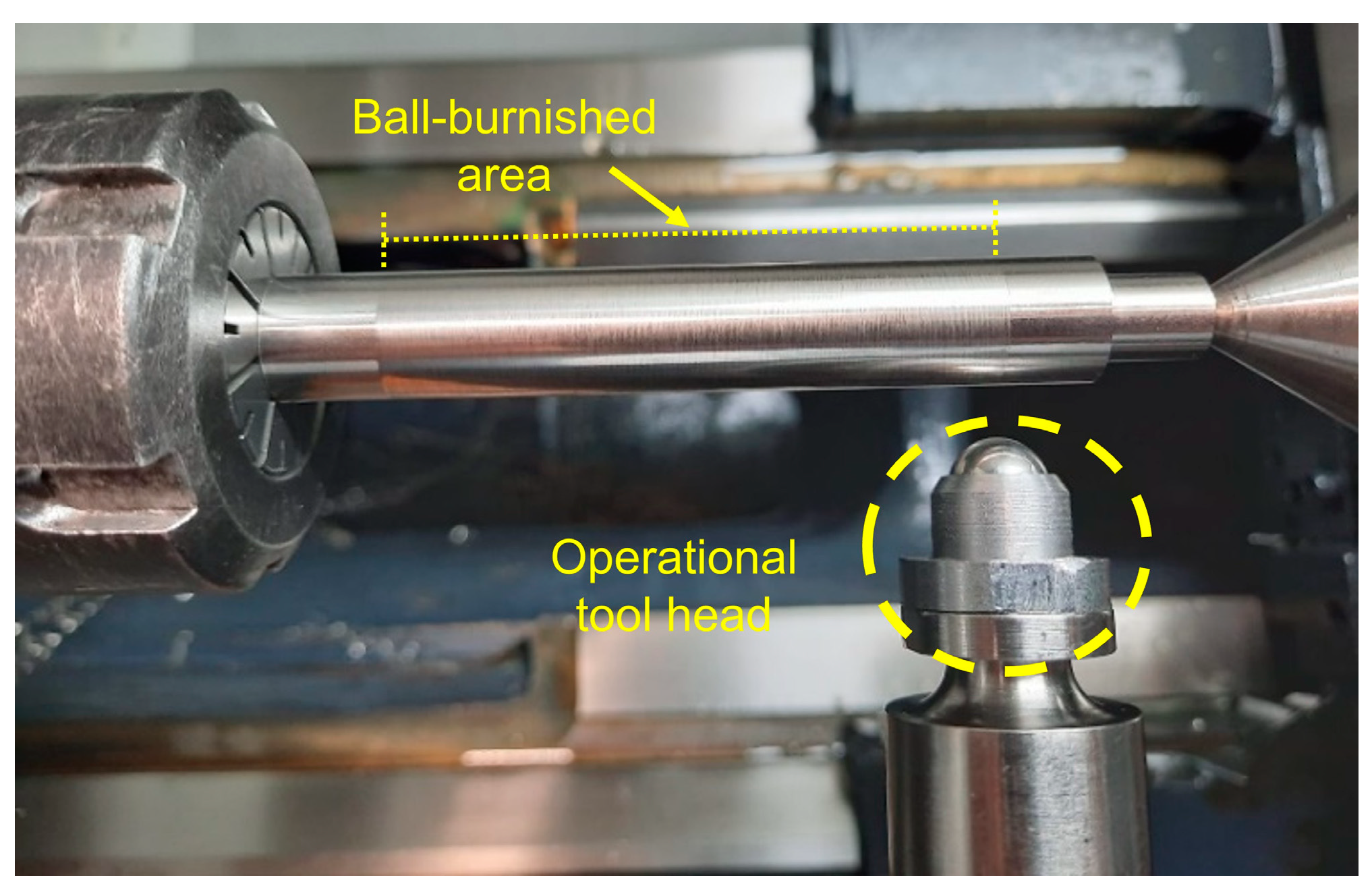

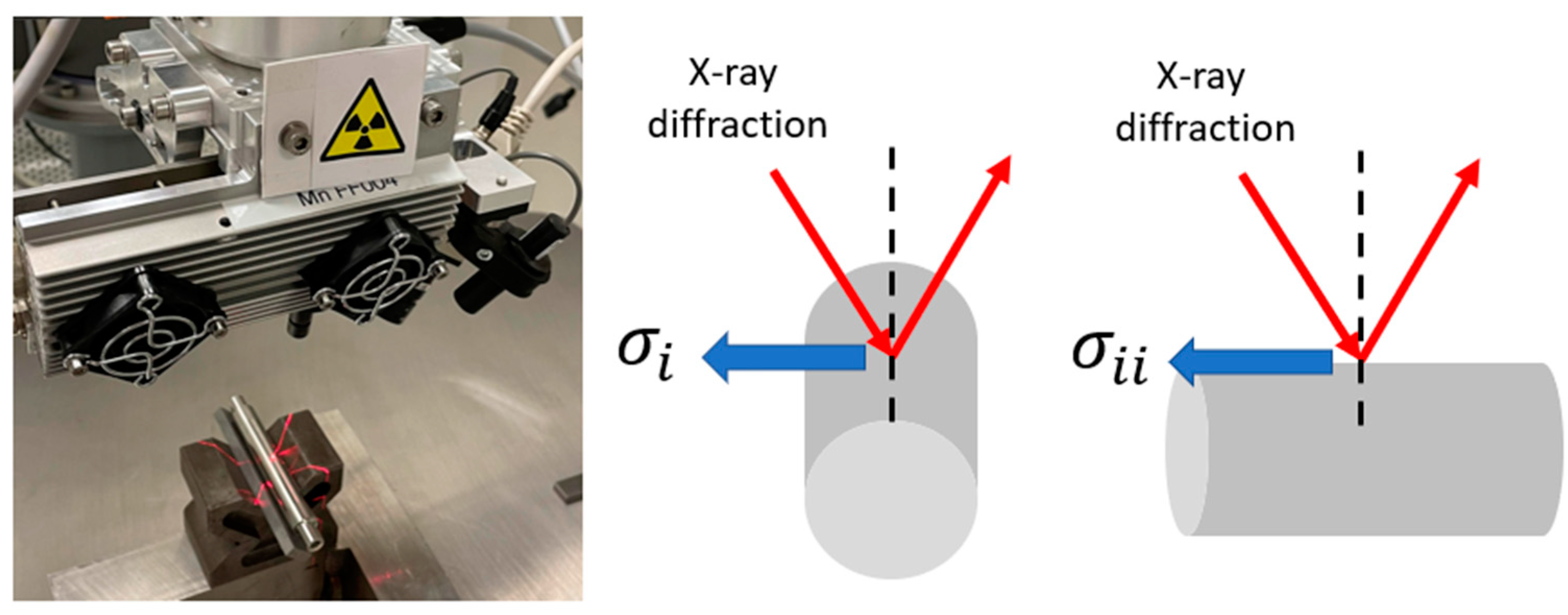
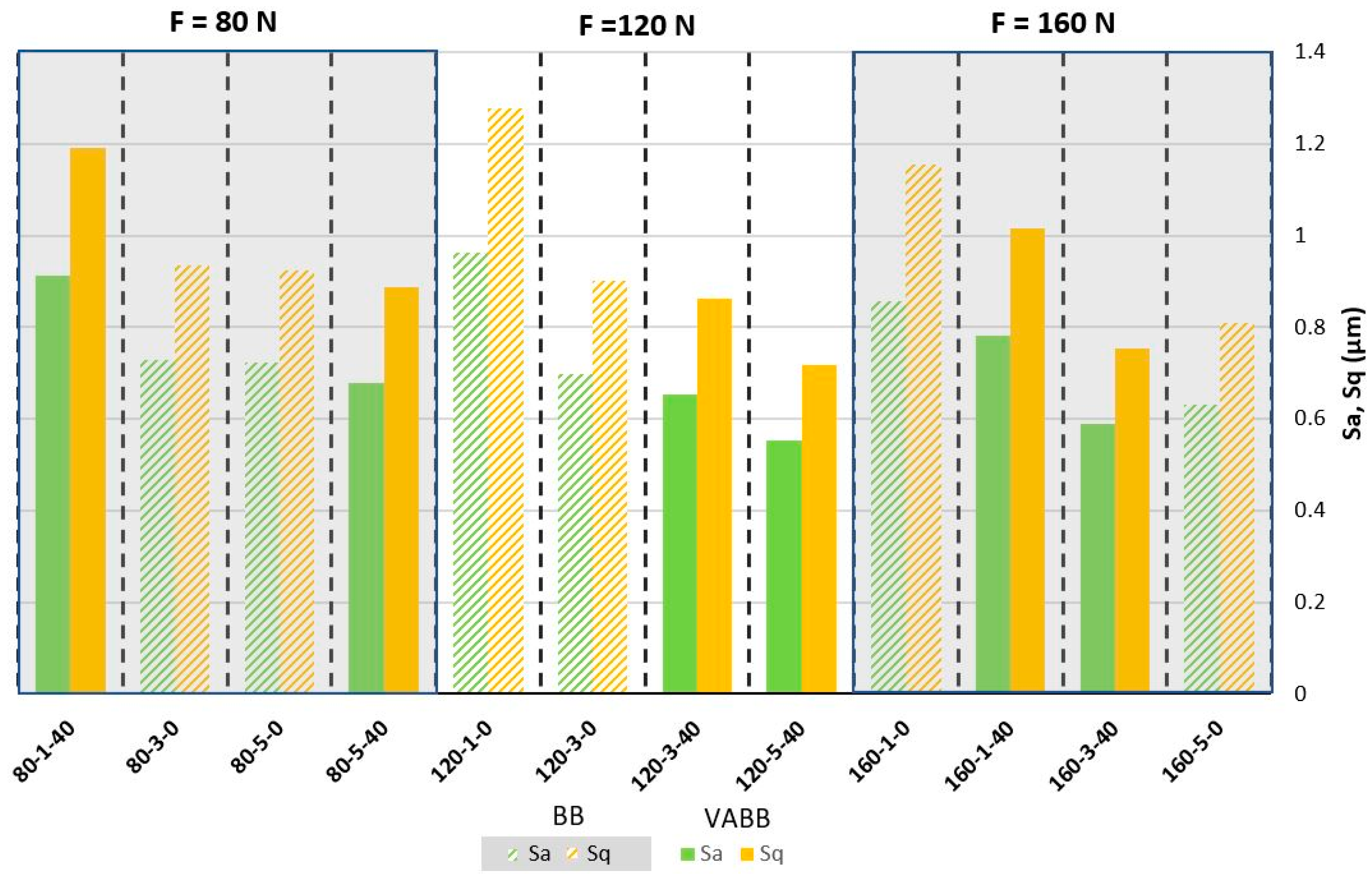
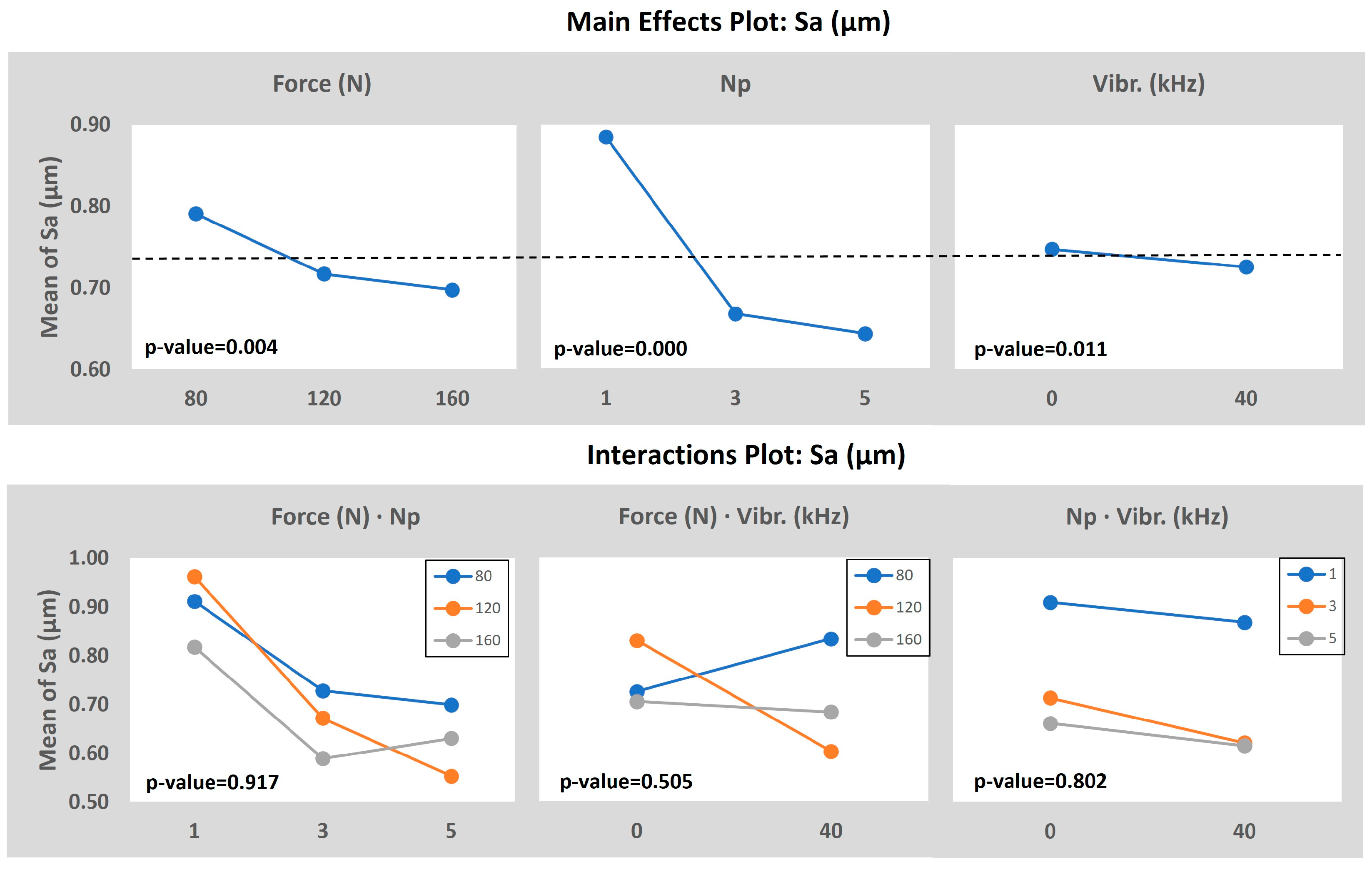
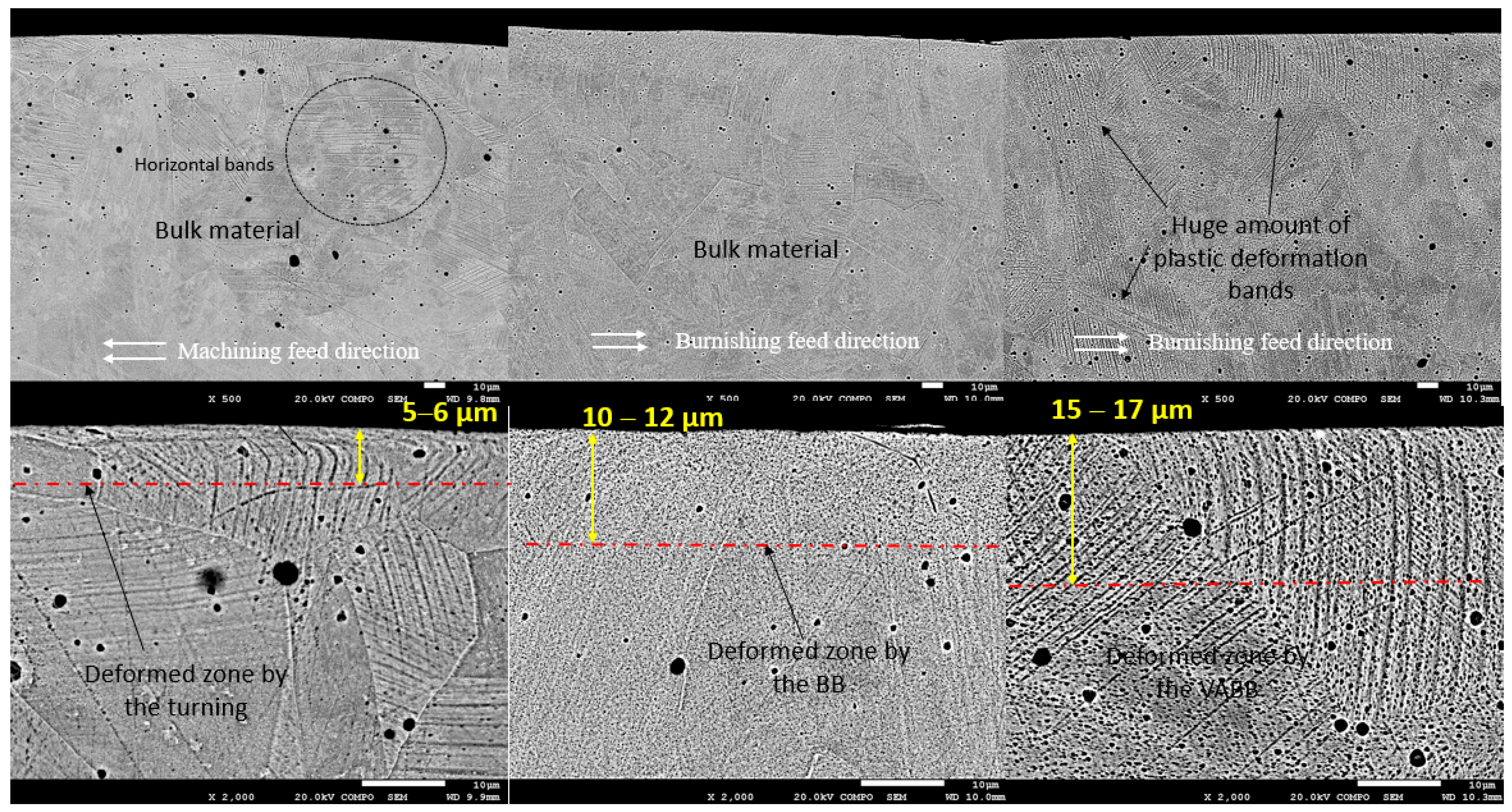
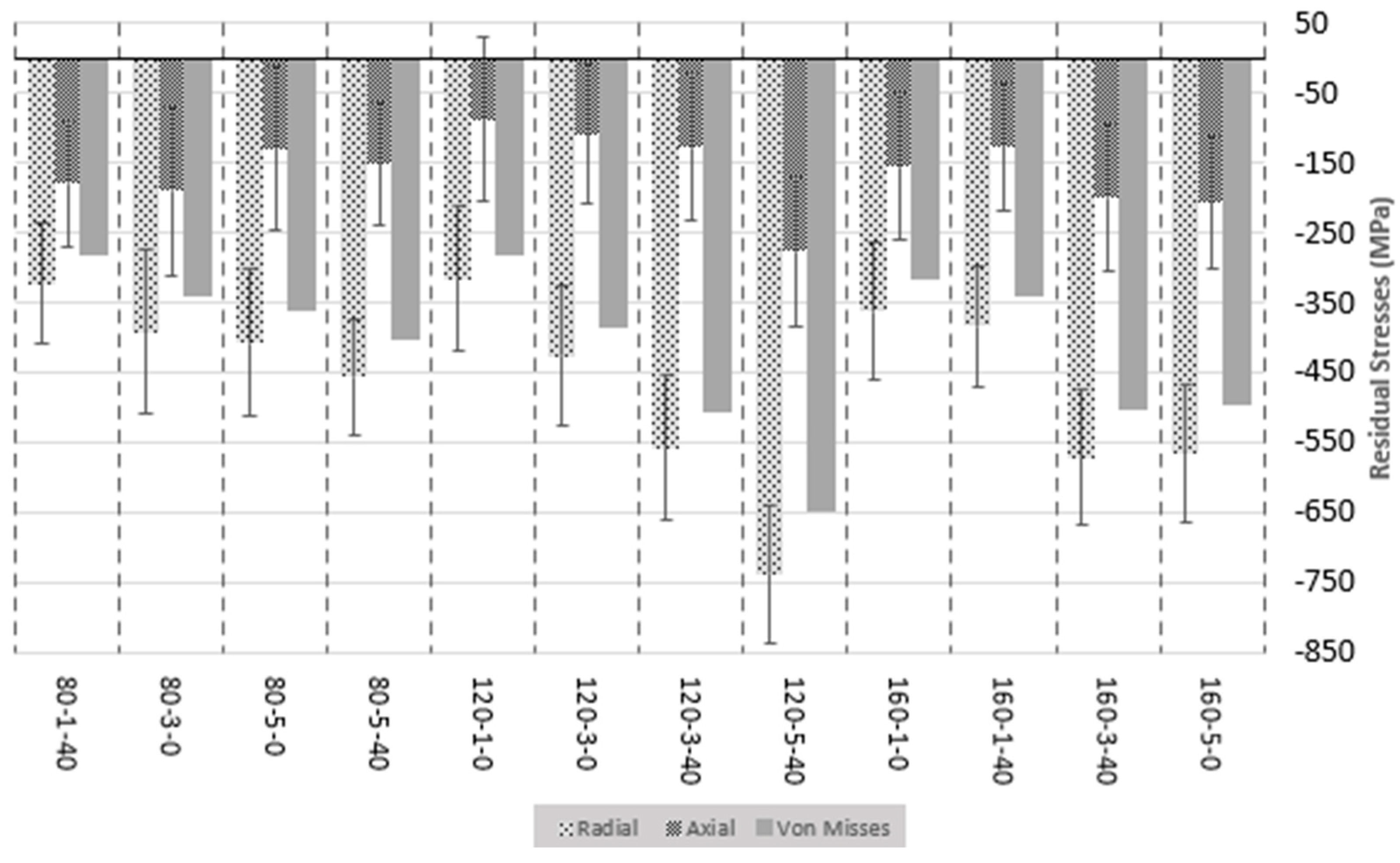
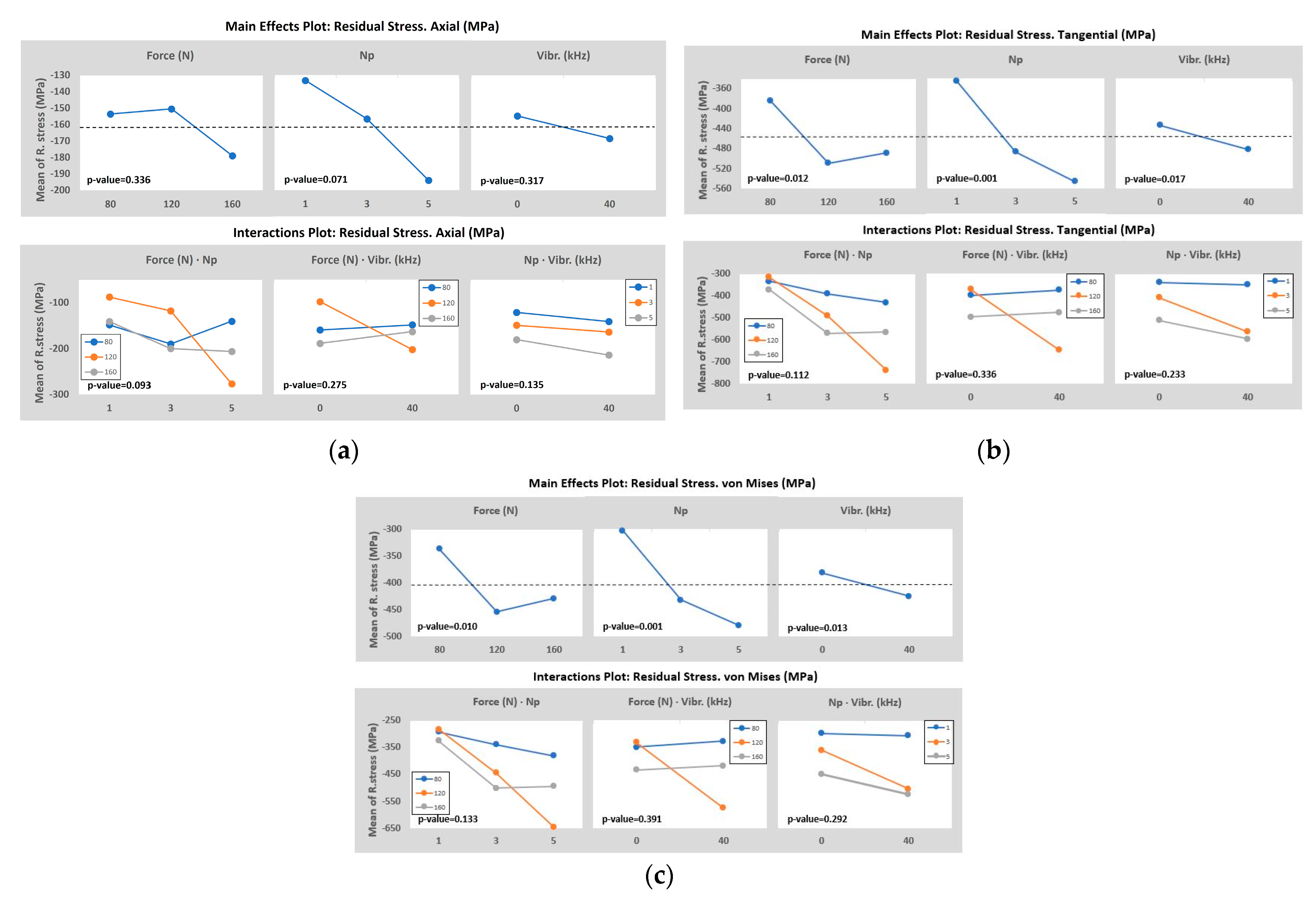
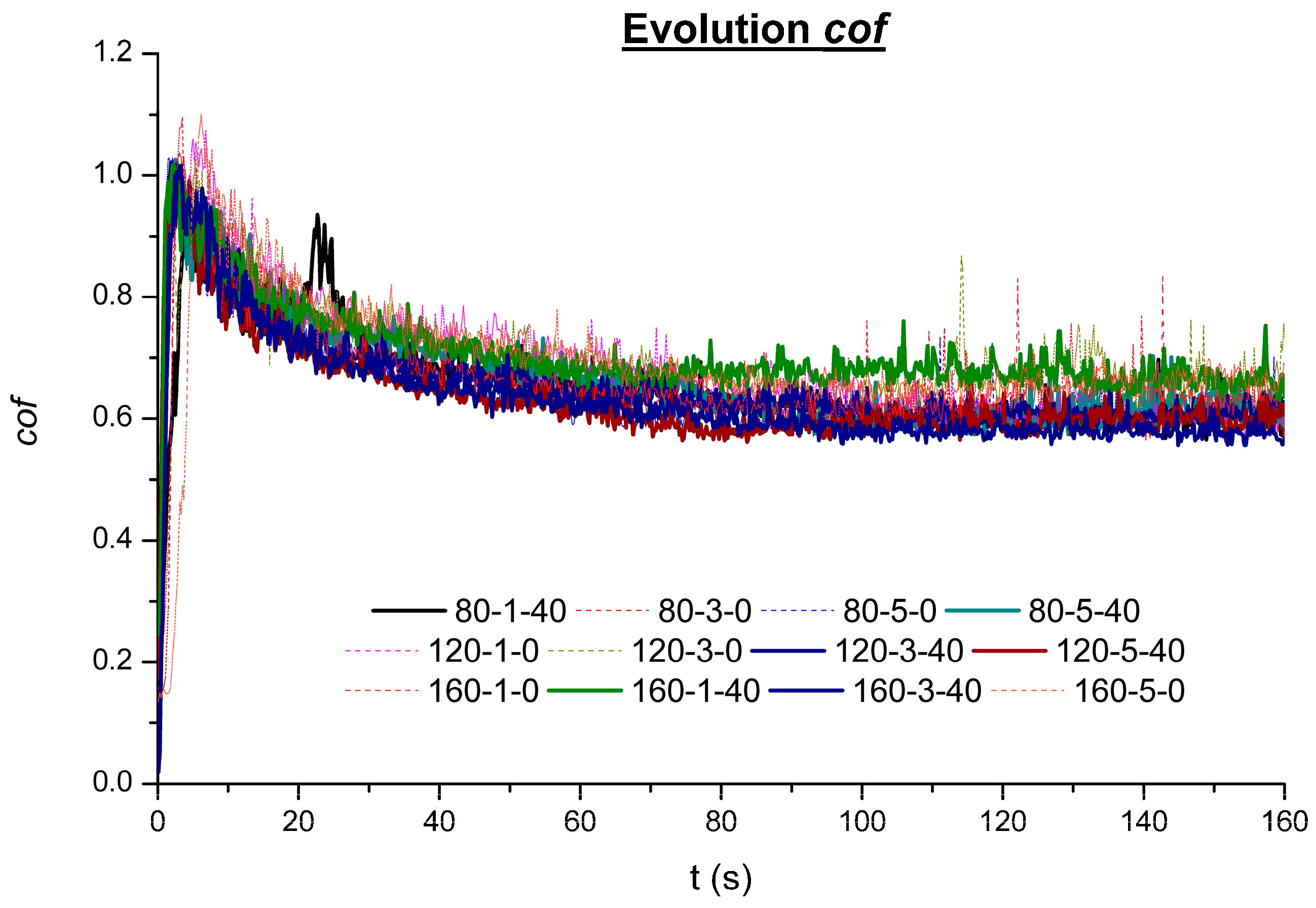

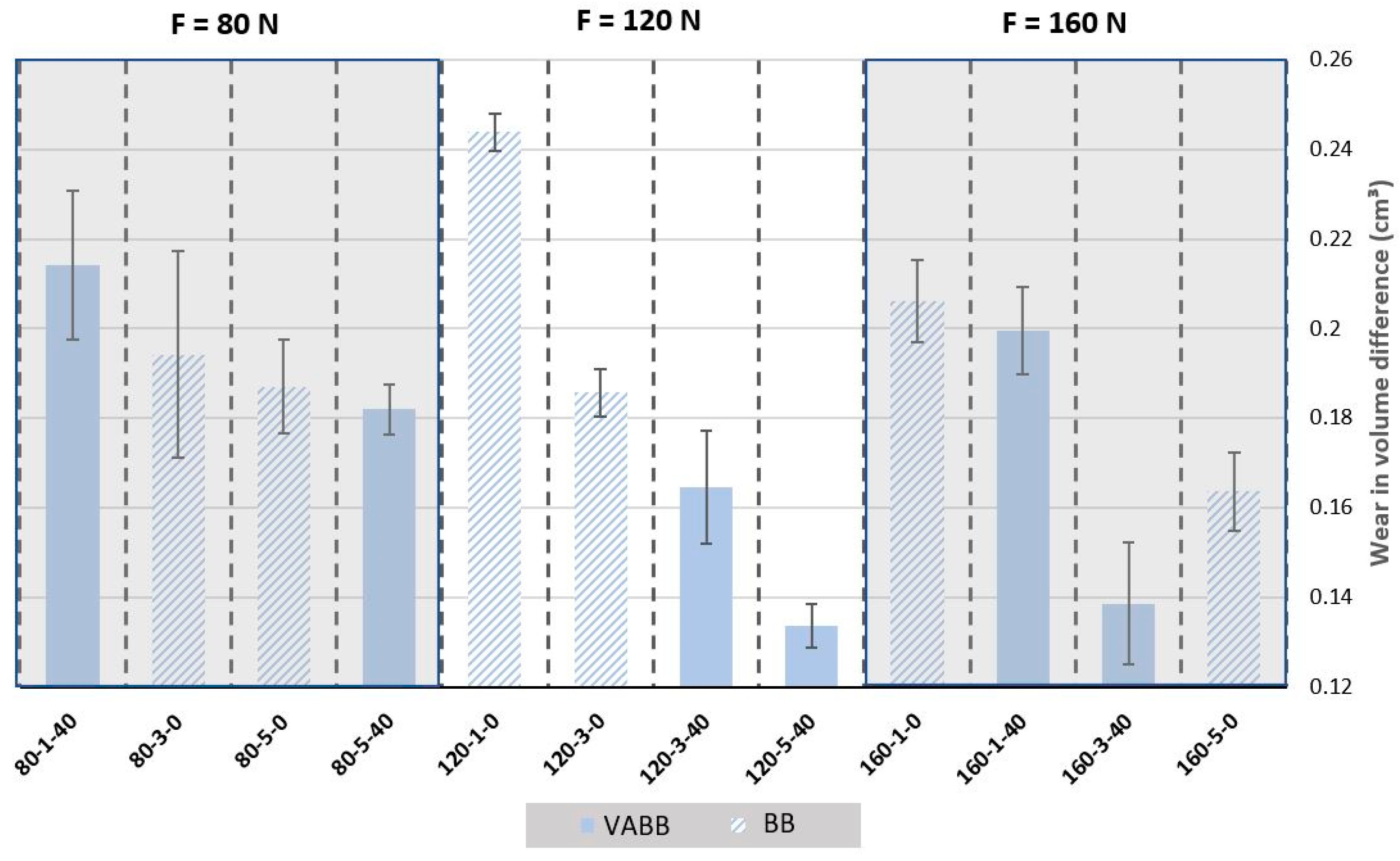
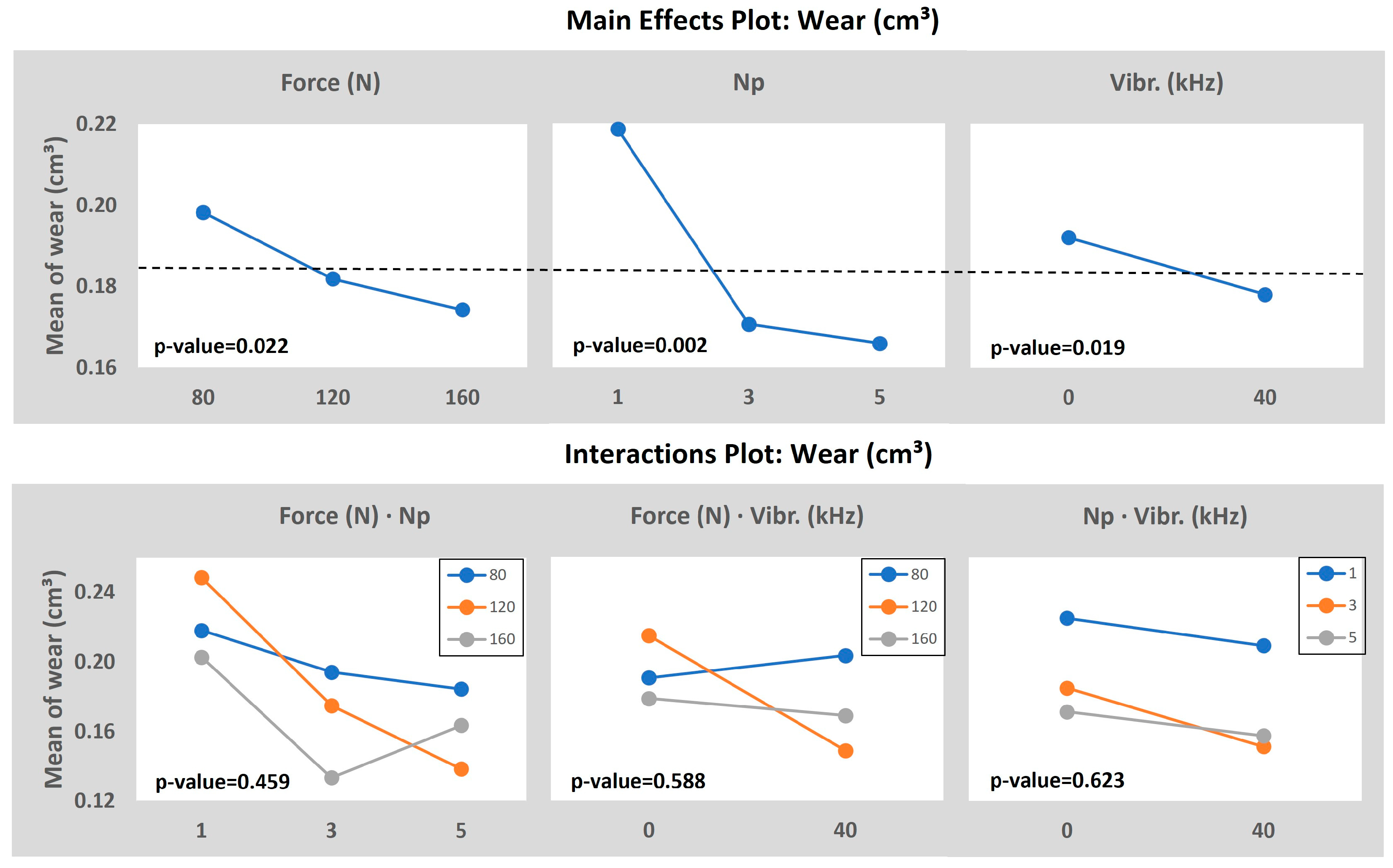
| Material | Chemical Composition by Element (wt. in %) | |||||||||
|---|---|---|---|---|---|---|---|---|---|---|
| AISI 316L | Fe | C | Si | Mn | P | S | Cr | Ni | N | Mo |
| Bal. | 0.03 | 1.00 | 2.00 | 0.05 | 0.02 | 17.50 | 11.50 | 0.10 | 2.00 | |
| Nomenc. | Fb (N) | np | f (kHz) |
|---|---|---|---|
| 80-1-40 | 80 | 1 | 40 |
| 80-3-0 | 80 | 3 | 0 |
| 80-5-0 | 80 | 5 | 0 |
| 80-5-40 | 80 | 5 | 40 |
| 120-1-0 | 120 | 1 | 0 |
| 120-3-0 | 120 | 3 | 0 |
| 120-3-40 | 120 | 3 | 40 |
| 120-5-40 | 120 | 5 | 40 |
| 160-1-0 | 160 | 1 | 0 |
| 160-1-40 | 160 | 1 | 40 |
| 160-3-40 | 160 | 3 | 40 |
| 160-5-0 | 160 | 5 | 0 |
| Nomenc. | Sa (μm) | ΔSa (%) |
|---|---|---|
| 80-1-40 | 0.912 | 39 |
| 80-3-0 | 0.729 | 51 |
| 80-5-0 | 0.723 | 52 |
| 80-5-40 | 0.678 | 55 |
| 120-1-0 | 0.963 | 36 |
| 120-3-0 | 0.699 | 53 |
| 120-3-40 | 0.654 | 56 |
| 120-5-40 | 0.554 | 63 |
| 160-1-0 | 0.856 | 43 |
| 160-1-40 | 0.781 | 48 |
| 160-3-40 | 0.590 | 61 |
| 160-5-0 | 0.631 | 58 |
Disclaimer/Publisher’s Note: The statements, opinions and data contained in all publications are solely those of the individual author(s) and contributor(s) and not of MDPI and/or the editor(s). MDPI and/or the editor(s) disclaim responsibility for any injury to people or property resulting from any ideas, methods, instructions or products referred to in the content. |
© 2023 by the authors. Licensee MDPI, Basel, Switzerland. This article is an open access article distributed under the terms and conditions of the Creative Commons Attribution (CC BY) license (https://creativecommons.org/licenses/by/4.0/).
Share and Cite
Velázquez-Corral, E.; Wagner, V.; Jerez-Mesa, R.; Lluma, J.; Travieso-Rodriguez, J.A.; Dessein, G. Analysis of Ultrasonic Vibration-Assisted Ball Burnishing Process on the Tribological Behavior of AISI 316L Cylindrical Specimens. Materials 2023, 16, 5595. https://doi.org/10.3390/ma16165595
Velázquez-Corral E, Wagner V, Jerez-Mesa R, Lluma J, Travieso-Rodriguez JA, Dessein G. Analysis of Ultrasonic Vibration-Assisted Ball Burnishing Process on the Tribological Behavior of AISI 316L Cylindrical Specimens. Materials. 2023; 16(16):5595. https://doi.org/10.3390/ma16165595
Chicago/Turabian StyleVelázquez-Corral, Eric, Vincent Wagner, Ramón Jerez-Mesa, Jordi Lluma, J. Antonio Travieso-Rodriguez, and Gilles Dessein. 2023. "Analysis of Ultrasonic Vibration-Assisted Ball Burnishing Process on the Tribological Behavior of AISI 316L Cylindrical Specimens" Materials 16, no. 16: 5595. https://doi.org/10.3390/ma16165595
APA StyleVelázquez-Corral, E., Wagner, V., Jerez-Mesa, R., Lluma, J., Travieso-Rodriguez, J. A., & Dessein, G. (2023). Analysis of Ultrasonic Vibration-Assisted Ball Burnishing Process on the Tribological Behavior of AISI 316L Cylindrical Specimens. Materials, 16(16), 5595. https://doi.org/10.3390/ma16165595









